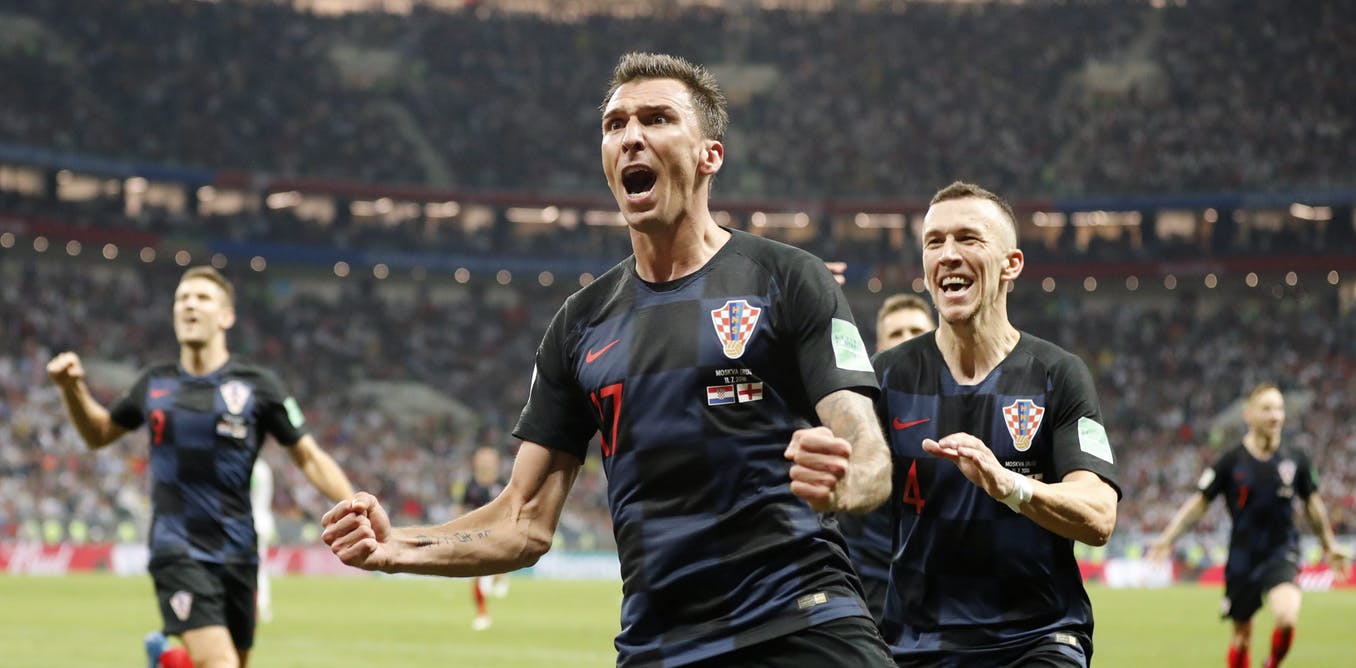Written by Nicole W. Forrester, Ryerson University. Photo credit AP Photo/Frank Augstein. Originally published in The Conversation.
Mario Mandzukic celebrates during Croatia’s victory over England in the World Cup semifinal. Croatia’s emphasis of team over individual goals was crucial to its success.
Sport and business often seem to share common ground when it comes to performance. It’s not uncommon for businesses to use sports metaphors such as “down for the count,” “the ball’s in their court,” or “full court press.” As an Olympian, I’m often invited to speak at corporate events to inspire employees on setting goals or resiliency.
But only recently has there been a burgeoning body of researchers in the field of sport psychology and organizational psychology exploring the parallels between sports and businesses.
One study compared and contrasted the perceived factors of organizational success from the viewpoints of leaders in the fields of sport and business. The results revealed sport and business leaders identified more similar factors (e.g., leadership, communication and team cohesion) than differences.
Many parallels exist between sports and business when it comes to success. The recent FIFA World Cup provides a unique opportunity to examine some of these parallels and provide lessons for both business and sport.
Few would have predicted France versus Croatia in the final match. If you glanced at the FIFA world rankings a week before the first match, you may have anticipated the 2018 World Cup champion to be Germany or Brazil, respectively ranked first and second.
It would have also been easy to assume the two teams with the greatest players in the game — Argentina with Lionel Messi and Portugal with Cristiano Ronaldo — might also be contenders for the title.
However, true to the nature of sport, this year’s World Cup delivered unpredictable results.
The Team, The Team, The Team
“No man is more important than The Team. No coach is more important than The Team. The Team, The Team, The Team, and if we think that way, all of us, everything that you do, you take into consideration what effect does it have on my Team?”
Bo Schembechler, former University of Michigan football coach
One of the most powerful lessons from the 2018 World Cup is the positive relationship team cohesion had with performance.
More than 40 years ago, Canadian sports psychologist Albert Carron wrote that team cohesion is “a dynamic process which is reflected in the tendency for a group to stick together and remain united in the pursuit of its goals and objectives.” It still holds true today.

There’s evidence that better team cohesion results in better performance, and better performance results in better team cohesion.
Studies on Olympians in team sports have identified team unity and trust among the most important factors for success, while teams that failed to achieve their expected results attributed it to planning and team cohesion problems.
Belgium surprised many World Cup fans by making it to the semifinals and eventually winning the third-place match. Team manager Roberto Martinez attributed Belgium’s success to “the notion of being a team. Individual skills and talent are important, but in these tournaments, it’s absolutely necessary to play as a team.”
Shared goals
Integral to team cohesion is a shared goal among all group members.
While each team consists of individuals with different roles and interests, their individual goals must support the team goal and not supersede it. Teams will struggle when an individual within the team places their needs above the rest.
Recognizing the importance of the team’s needs, Croatia’s coach, Zlatko Dalic, made a difficult decision when he sent striker Nikola Kalinic home after their opening game in the World Cup. Kalinic had refused to go on the field in the 85th minute of the game, saying he had back pain. However, it’s believed he may have been demonstrating his displeasure for being benched in the game.

Acknowledging some problems in the camp, Dalic refused to elaborate or discuss Kalinic, simply stating “…since I need my players fit and ready to play, I have made this decision.”
In this example, the coach took action to preserve the team chemistry and commitment to their shared goal by removing a player who appeared to place his own wants ahead of the team. Croatia was an example of a team in which the whole was greater than the sum of its parts.
When team members understand their role as it relates to the team goal, it can assist with buy-in and commitment. In business, it has been found to be associated with greater job satisfaction.
The importance of resiliency
Researchers have established resiliency to be a characteristic demonstrated by successful athletes and teams. A British study in 2015 of a rugby union World Cup-winning team found team resilience to be supported by five main psychosocial processes: Transformational leadership, shared team leadership, team learning, social identity and positive emotions.
This was also a theme cited by soccer analysts in the 2018 World Cup — most notably when Belgium overcame a 2-0 deficit to defeat Japan in the quarter-final match. Belgium scored three goals in the final 30 minutes. Such a comeback means the players stayed focused and avoided getting down on themselves. Additionally, controlling one’s composure and providing positive feedback to teammates can further bolster the teams’ collective confidence.
Anchored in their pursuit of excellence, it is easy to see the link between sport and business. Understanding your role on a team, aligning behind a common objective and putting team goals ahead of individual needs are strategies that work on the field of play — in the boardroom.


